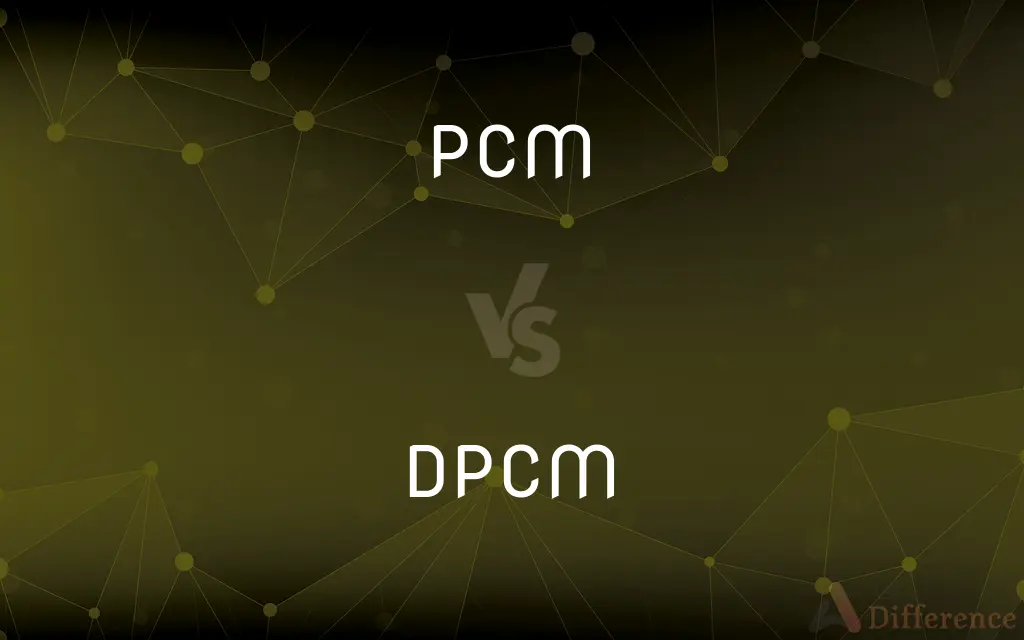PCM vs. DPCM — What's the Difference?
By Tayyaba Rehman — Published on January 13, 2024
PCM (Pulse Code Modulation) converts analog signals to digital by sampling, while DPCM (Differential PCM) encodes the difference between successive samples.

Difference Between PCM and DPCM
Table of Contents
ADVERTISEMENT
Key Differences
PCM, or Pulse Code Modulation, is a method used to digitally represent analog signals. In PCM, the amplitude of the analog signal is sampled at regular intervals and then quantized to a series of values. DPCM, or Differential Pulse Code Modulation, is a variation of PCM. It records the difference between successive samples rather than recording each sample independently.
In PCM, each sample is independent of the others, and the quality of the digital signal is highly dependent on the sampling rate and bit depth. Higher sampling rates and bit depths result in better quality but also require more storage space. DPCM, in contrast, reduces the amount of data needed by encoding only the difference between consecutive samples, which tends to be smaller than the samples themselves.
PCM is straightforward in its approach but can result in large file sizes, especially with high-quality audio signals. This format is commonly used in CDs and digital phone systems. DPCM, on the other hand, is more efficient in terms of data storage. By focusing on the differences between samples, DPCM can achieve a lower bit rate, making it suitable for compressing audio and video signals.
The simplicity of PCM makes it robust and easy to implement in hardware. Its straightforward nature ensures consistent quality at the cost of larger data sizes. DPCM, while more complex, excels in applications where bandwidth or storage efficiency is a priority, as it effectively reduces redundancy in signal representation.
PCM is the foundation of digital audio and is essential for any application requiring high fidelity. DPCM is an extension of PCM, optimized for applications where bandwidth and storage efficiency are more critical than the absolute fidelity of the signal.
ADVERTISEMENT
Comparison Chart
Method of Conversion
Converts analog signals to digital by sampling
Encodes differences between successive samples
Data Representation
Each sample is independent
Samples represent change from the previous sample
Data Size and Quality
Larger file size, higher quality
Smaller file size, quality depends on the differences
Complexity and Implementation
Simple and robust
More complex, efficient for storage and bandwidth
Typical Applications
Used in CDs, digital phone systems
Suitable for audio and video compression
Compare with Definitions
PCM
PCM maintains high fidelity in digital representation.
PCM is used in professional audio recording to ensure high-quality sound.
DPCM
DPCM adjusts each sample based on the previous one.
DPCM modifies each new audio sample slightly, based on its predecessor.
PCM
PCM samples are quantized to a series of discrete values.
PCM converts an analog signal into a sequence of binary numbers.
DPCM
It's a variant of PCM focusing on data efficiency.
DPCM is used in video compression to reduce the size of the data stream.
PCM
It's a fundamental technique in digital audio.
PCM is the basis for audio formats like WAV and AIFF.
DPCM
DPCM encodes the difference between successive samples.
DPCM reduces data size by only recording changes in the audio signal.
PCM
PCM is a method of converting analog signals into digital form.
In PCM, an audio waveform is sampled at regular intervals to create a digital representation.
DPCM
DPCM is suitable for signals with low amplitude changes.
In DPCM, voice recordings are efficiently compressed due to minimal variations.
PCM
It involves sampling the amplitude of the analog signal.
PCM technology is employed in CD audio recordings, sampling at 44.1 kHz.
DPCM
It helps in reducing the bit rate for transmission.
DPCM is effective in telecommunication systems for bandwidth optimization.
Common Curiosities
How does DPCM differ from PCM?
DPCM encodes the difference between successive samples, unlike PCM which samples each point independently.
What are typical uses of PCM?
PCM is widely used in CD audio and digital telephony for high-quality sound representation.
Can PCM provide high-quality audio?
Yes, PCM is known for its high fidelity in digital audio applications.
What is PCM?
PCM is a digital representation technique for analog signals, involving regular sampling and quantization.
Is DPCM more efficient than PCM?
Yes, DPCM is more efficient in terms of data storage and bandwidth usage.
What's a key drawback of DPCM?
DPCM's reliance on differential encoding can introduce errors in dynamic signals.
Does DPCM affect audio quality?
DPCM may slightly compromise quality for efficiency, especially in dynamic audio.
Is DPCM suitable for all types of audio?
DPCM is best for audio with minimal amplitude changes, like voice recordings.
How does PCM impact file size?
PCM often results in larger file sizes due to its high-quality, detailed sampling.
What's the main advantage of PCM?
PCM's main advantage is its ability to maintain high audio quality.
Is PCM easy to implement?
Yes, PCM's straightforward approach makes it relatively easy to implement in hardware.
Why is DPCM used in video compression?
DPCM efficiently compresses video by encoding only the changes between frames.
Are PCM and DPCM compatible?
DPCM is a derivative of PCM, so they share foundational principles but differ in application.
Can DPCM reduce transmission costs?
Yes, its efficient data representation can reduce costs in data transmission.
Are PCM and DPCM still relevant?
Absolutely, both are foundational in modern digital audio and video technologies.
Share Your Discovery

Previous Comparison
Bank Overdraft vs. Bank Loan
Next Comparison
Vibrant vs. WarmAuthor Spotlight
Written by
Tayyaba RehmanTayyaba Rehman is a distinguished writer, currently serving as a primary contributor to askdifference.com. As a researcher in semantics and etymology, Tayyaba's passion for the complexity of languages and their distinctions has found a perfect home on the platform. Tayyaba delves into the intricacies of language, distinguishing between commonly confused words and phrases, thereby providing clarity for readers worldwide.
















































